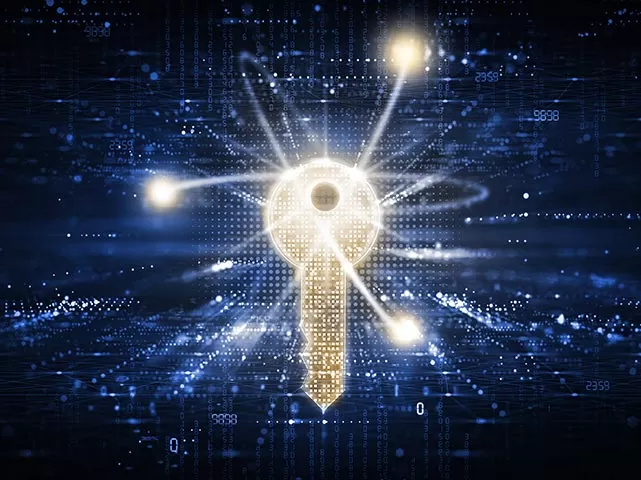
Schrödinger's Cat's Two-Way Radio
How quantum mechanics transform secure battlefield and intelligence communications? Elbit Systems' ISTAR & EW R&D director unveils the path to unbreakable data transfers.
Imagine a box with a cat in it. It isn't until you open it that you can acknowledge whether the cat is alive or dead. By opening the box and discovering its state, you actually cause it to become either. This mind-bending paradox, known as the Schrödinger's cat problem, perfectly illustrates the peculiar nature of quantum mechanics.
Now, imagine harnessing this strange phenomenon of physics to create unbreakable communication channels. This is the frontier Elbit Systems-ISTAR & EW – Elisra division is exploring with their avant-garde research in quantum communication.
The Achilles' Heel of Classical Encryption
P, a physicist and R&D specialist at the ISTAR & EW Division, has been at the forefront of this quantum journey. "We've been working on quantum communication for the past four years, building the necessary frameworks and securing funding from the Israeli Innovation Authority," he says.
The challenge? To create a secure method of transferring encryption keys that remains impervious even to the formidable capabilities of quantum computers.
In today's world, encryption methods such as RSA rely on the sheer complexity of mathematical algorithms to secure data. These problems are so intricate that they would take classical computers millions of years to solve. However, quantum computers implementing appropriate algorithms, which already threaten to unravel this security in mere hours.
"The arrival of quantum computing renders traditional asymmetric encryption methods obsolete," P explains. "This realization has pushed the world to seek quantum-resistant solutions and leverage quantum properties for secure information transfer."
The Quantum Leap
Elbit Systems' solution lies in Quantum Key Distribution (QKD), a method that exploits principles of quantum mechanics to ensure secure communication.
But first, how are quantum principles used in computing technology? Unlike classical computers, which use bits as the smallest unit of data (representing either 0 or 1), quantum computers use quantum bits, or qubits. Qubits can exist in multiple states simultaneously due to a phenomenon called superposition, allowing them to process a vast number of possibilities at once.
This unique capability enables quantum computers to solve certain complex problems much faster than classical computers, such as breaking traditional encryption methods. Although still in the early stages of development, quantum computing promises to transform various industries by providing unprecedented computational power and problem-solving abilities.
And accordingly, at the heart of QKD is the concept of superposition, where a quantum particle, like a photon, can exist in multiple states simultaneously. However, upon measurement, it collapses into a single state, making it impossible to clone or intercept without detection.
"In QKD, we transmit photons between two parties, A and B," P elaborates. "These photons carry information to create encryption keys. If an eavesdropper tries to intercept some key bits, the quantum state collapses, and the intrusion is detected immediately."
Elbit Systems-ISTAR & EW-Elisra, working alongside Triarii Research, has successfully demonstrated Free Space QKD in outdoor daylight settings, achieving secure data transfer rates of up to 10 kilobits per second over hundred meters range. While this may not seem substantial in terms of volume, the focus is on proving the technology and understanding its potential.
"Our goal was to develop a secure communication channel using quantum principles, implementing either single photons or entangled photons technologies " says P. "We integrated Elbit Systems' modems at both ends to establish a classical AES symmetric encrypted channel using the quantum-generated keys. This aims to ensure that even if a device falls into enemy hands, the encryption keys remain secure."
The Next Steps
Advancing this technology requires major scaling for broader applications and uses. "We're working on extending the range and increasing the data transfer rate," P states. "Our ultimate aim is to implement this technology across various military units in the field, ensuring secure communication channels that are resilient to quantum threats."
With significant investments in quantum labs and infrastructure, Elbit Systems is poised to lead the charge in this new era of secure communication. As P puts it, "Quantum communication represents a potential monumental leap forward in safeguarding our data, aiming to ensure that even the most advanced computational threats cannot breach our defenses."
By embracing the enigmatic principles of quantum mechanics, Elbit Systems is paving the way for resilient battle communications and pioneering new EW and intelligence-gathering measures.
The content of the article does not constitute business or financial information about Elbit Systems Ltd. (the "Company") and is not intended to be a basis for making investment decisions in the Company's securities. In order to obtain business or financial information about the Company, please refer to the reports and filings that the Company regularly publishes on the website of the U.S Securities and Exchange Commission (EDGAR) and on the notification system of the Tel Aviv Stock Exchange (Maya).
The article may contain forward-looking statements such as estimates, forecasts, estimates, plans, etc. that refer to future events that are considered forward-looking information as defined under the securities laws of Israel and the United States. There is no certainty that such information will be realized, in whole or in part, and the actual result may differ from what was presented in the article, among other things due to its dependence on external factors that are not under the control of the Company and that cannot be evaluated in advance. The forward-looking statements are based on the Company's estimates at the time of publication, and the Company has no obligation to update or correct this data.

